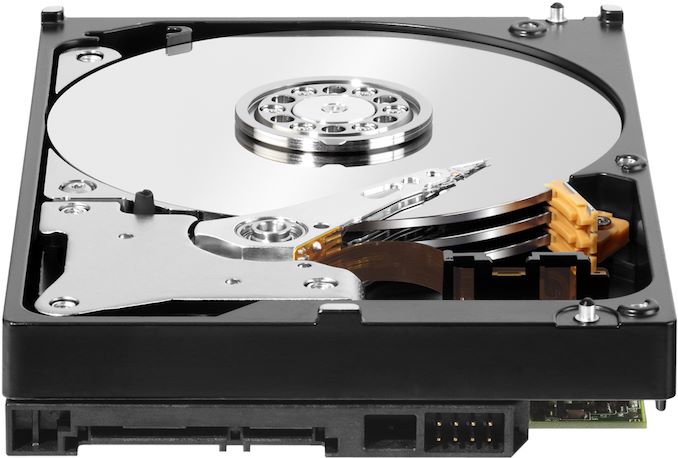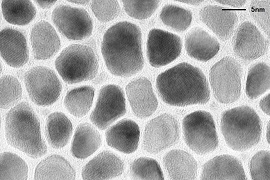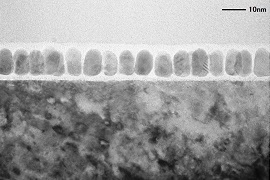The Road to 80 TB HDDs: Showa Denko Develops HAMR Platters for Hard Drives
by Anton Shilov on February 6, 2020 2:30 PM EST- Posted in
- Storage
- Seagate
- Toshiba
- Western Digital
- HAMR
- Showa Denko
- SDK
- HDD

Showa Denko K.K. (SDK) has unveiled the the company has finished the development of its next-generation heat assisted magnetic recording (HAMR) media for hard drives. The platters use all-new magnetic thin films with a very small crystal grain size in order to maximize their areal density, with the goal of eventually enabling 3.5-inch HDDs to be built with capacities of 70 TB to 80 TB.
SDK’s platters for HAMR HDDs use glass substrate and feature thin film magnetic layer made of an Fe-Pt alloy. To improve the magnetic coercivity of the media by several times over existing platters, Showa Denko used a new structure of magnetic layers and implemented new ways of controlling the temperature of the media during production.
UPDATE 2/21: As it turns out, Showa Denko will use glass substrates for platters designed for HAMD hard drives because of their superior heat resistance.
Driving these developments, it's critical to maximize the magnetic coercivity of next generation HDD platters because the crystal grains used to record data are getting extremely small. This has made them very easy to magnetize, but it has also reduced the strength of the individual magnetic signatures, which creates an unwanted magnetic inter-track interference (ITI) effect that makes it harder for HDD heads to read the data. Platters with high magnetic coercivity require energy assistance during writing and this is what energy assisted magnetic recording technologies (HAMR, MAMR, ePMR, etc.) are all about. Meanwhile, the platters must survive extreme temperatures they are subjected to during heat-assisted recording. According to Showa Denko, its new HAMR platters offer the industry’s highest read-write characteristics and durability.
Transmission Electron Microscopy Images of HAMR Media
Plain View Cross Section
SDK is not disclosing the recording density of its new platters nor are they making specific promises about when it intends to start mass production of next-generation disks. Meanwhile, the company notes that today’s leading-edge conventional magnetic recording (CMR) platters feature recording density of about 1.14 Tb/in2 and it is widely believed that this is not going to grow significantly without using energy assisted recording methods. By contrast, Showa Denko believes, HAMR-based media will achieve areal density of 5-6 Tb/in2 in the future, which will increase capacity of hard drives by several times, all the way to 70 TB – 80 TB per 3.5-inch drive without increasing the number of platters. For comparison's sake, today’s 16 TB CMR (PMR+TDMR) HDDs use nine disks, so increasing their density by ~5.2X would enable drives featuring capacities higher than 80 TB.
Showa Denko is the world’s largest independent maker of platters for hard drives, selling media to all of the HDD producers. That said, the large manufacturers — Seagate and Western Digital — also produce media themselves and tend to use their own leading-edge platters to cut costs and maximize product margins. So it will be interesting to see which of three remaining hard drive makers will be the first to use HAMR platters from Showa Denko.
Seagate will be the first company to adopt HAMR for commercial 20 TB drives in late 2020, but since Showa Denko now only plans to ‘make preparations for full-scale supply of the new HD media’, it is likely that the first HAMR drives will use Seagate’s own platters. Toshiba is expected to use Showa Denko’s 2 TB MAMR platters for its 18 TB HDDs that are projected to arrive later this year, but in the longer terms it will switch to HAMR (we have no idea when). By contrast, Western Digital uses its so-called energy-assisted PMR (ePMR) technology for its 18 TB and 20 TB HDDs due this year and will gradually move to MAMR and HAMR in the years to come.
Related Reading:
- Toshiba's HDD Tech Roadmap: A Mix of SMR, MAMR, TDMR, and HAMR
- 18 TB HDDs: Toshiba Collaborates with Showa Denko for MAMR HDDs
- HOYA Starts to Build Next-Gen HDD Glass Substrate Production Facility
- Seagate: 18 TB HDD Due in First Half 2020, 20 TB Drive to Ship in Late 2020
- Western Digital Roadmap Updates: Energy Assisted Recording, Multi-Stage Actuators, Zoned Storage
Source: Showa Denko












75 Comments
View All Comments
Brane2 - Friday, February 7, 2020 - link
Over the past decade they increased the bandwidth of a SINGLE HEAD, which was the same as longitudinal density increase.Now they have brought in mechanisms that make MULTIHEAD data transfer possible, so corresdponding multiplicators are likely ( 18 heads on 9 platters, twice that with two arms etc).
sheh - Friday, February 7, 2020 - link
Let's get 2 actuator drives into the market first, then see about more concurrently active heads. :)Gigaplex - Friday, February 7, 2020 - link
If the data you need is all on a single platter, all those extra heads aren't going to help.sheh - Friday, February 7, 2020 - link
You can write across multiple surfaces.Targon - Thursday, February 6, 2020 - link
Another development that will be obsolete in another ten years. As it stands currently, solid state drives have an issue with decay when unpowered for extended periods. If that issue is addressed where drives can be unpowered for ten years without data loss or corruption, that will resolve THAT issue and solid state drives will be good for data backups for most people.Next comes data volume. With the ability to get 4TB onto a M.2 2280 drive, a larger physical drive could then be made. getting to 80TB in a 3.5 inch sized drive really wouldn't be that difficult, but with much higher data transfer speeds. The form factor, something like a PCIe 4.0 16 lane card could do the trick as well to get 80TB done. Again, the only current issue is shelf life if the machine is left unplugged for an extended period of time.
In ten years, would there be any reason to go magnetic at the rate of SSD development as long as the big unpowered issue is no longer an issue? High capacity platters are still subject to problems like head crashes.
extide - Thursday, February 6, 2020 - link
There are already 50TB 3.5" SSD's. The issue is price.bill.rookard - Thursday, February 6, 2020 - link
Yeah - when Samsung put out the 15.7TB SSD, the MSRP on that one was in the neighborhood of $10k. I'm sure it's come down a bit since then, and they also released a 30TB drive. Not sure on the price for that one. These are both in the 2.5" format.Seagate put out a 60TB 3.5" drive, and I'm sure that's in the range of 'stupidly expensive'.
HardwareDufus - Thursday, February 6, 2020 - link
Heat too...MenhirMike - Thursday, February 6, 2020 - link
In ten years, who knows. But from now for the next 10 years? Yeah, storage density per $ is much better with spinning rust.PeachNCream - Thursday, February 6, 2020 - link
I would think that as density increases on mechanical drives, we may begin to see data corruption from background level EMI impact long-term unpowered HDDs as we are already seeing with SSDs. What we really need is to put NAND and mechanical drives behind us by using storage technologies that mix the P/E durability and cold storage longevity of mechanical drives with the high throughput, low latency, and physical shock resistance of NAND. I was hopeful about Optane/Xpoint, but that technology and other potential replacements are simply not developing very quickly so we are instead getting a variety of bandaid and stopgap solutions on both sides of the storage development fence that fail to address the fundamental problems of each respective data storage method.